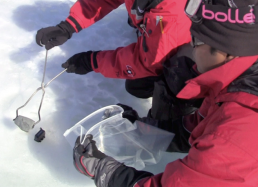7. The Meteorite Collection Process
I thought I’d begin my blog post by giving you a brief introduction to Antarctic meteorite collecting. The process was developed by the scientific community over time, and these procedures have now been formalized as a set of rules that govern the collection of meteorites in Antarctica. Many other programs, such as The Antarctic Search for Meteorites (ANSMET)—and now the Geological Survey of India—have implemented these procedures.
The goal of meteorite collecting in Antarctica is to recover meteorites for scientific study, with the prospect of finding rare and new types. The process itself works to minimize contamination and maximize the preservation of a meteorite’s scientific value during collection, transportation, storage, and curation.
And of course, the ultimate aim is to make samples of these meteorites available to the scientific community for further studies, including research on the formation and evolution of our solar system—and the origins of life on our planet. (For more details about what we’ve learned so far, check out my Studying Meteorites Photo Gallery.)
So on a beautiful field day out on the ice, we documented the careful meteorite collection process with a dark terrestrial rock that we used as a stand-in for a meteorite. (To see step-by-step photos of this process, take a look at my new Collecting Meteorites Photo Gallery.)
First, we examined our “specimen” at close range with a hand lens—but no hands—to determine if it was a meteorite or “meteorwrong!” (see above photo.) As tempting as it might be to hold a newly discovered Antarctic meteorite, it should never be touched—either with bare hands or gloves. This ensures that any important chemicals it carries won’t be contaminated or lost.
Next, we recorded our “specimen’s” GPS coordinates, the date and time it was discovered, a brief description of its appearance, and the conditions in which we found it (whether was it embedded in snow or ice, etc.) The finder must be honest and record every detail—especially anything unusual, such as if he accidentally touched or stepped on the meteorite! Otherwise, the truth will come out during “forensic” chemical analyses later. Any sort of human contamination leaves obvious “fingerprints,” which sheds a bad light on the field party!
For the next part of our process, we assigned our “specimen” a unique identifying number, and—using a counter displaying this identifier as a scale for size—we took a good photograph (See Photo #1 below.) Then we used a clean, stainless-steel tool to place the “specimen” in a new, labeled plastic bag, which went inside another clean bag; double bagging is important as it reduces the chances of contamination if the outer bag gets punctured (see Photo #2 below.)
Finally, we placed the “specimen” in a cooler for transportation to camp. Meteorites must be stored at or below 5° F (-15° C) throughout the collection process. Only at the final curatorial facility can meteorites be removed from their transportation freezers and brought to room temperature in stainless steel storage cabinets filled with inert gasses (preferably nitrogen or argon—see Photo #3 below).
If a meteorite were to thaw in normal air, condensation would form on its surface, dissolving away or altering water-soluble compounds and rendering them lost to science forever. The key is to avoid any contact with water, dirty tools, surfaces, skin, and clothing. Once a meteorite has been safely thawed, small chips can be removed and used for studying and classifying the specimen.
The meteorite’s information is entered into an inventory database and shared with the nomenclature committee of the Meteoritical Society. As the international authority in meteoritics, this organization approves the classification and final name of the meteorite. Only then can qualified scientists from around the world request samples for study and publication.
Now that I’ve filled you in on the basic meteorite collection process, I can share with you our latest news. Over the last several days, bad weather and high winds have prevented us from leaving the station, and the forecast says that these poor conditions will persist until I leave at the end of the week (see Photo #4 below.) Also, we’ve just learned that an unexpected month-long delay in the delivery of supplies means that a fuel shortage will limit our travel to field sites.
Weather and logistics are the deciding factors in an environment as difficult as Antarctica, and we've had to adjust our schedule accordingly. It’s a good thing that we’ve already successfully completed two of our major tasks: the geological and geophysical surveys, and our training sessions in meteorite prospecting and collecting.
This morning I received a message from Dale Andersen that he and his team at Untersee also got idled by the weather and are awaiting their transfer to the Antarctic Airport at Novo. He reported that, luckily, he was able to complete all of his major tasks.
During this bad weather, I gave a presentation on meteorites and their careful collection and curation to the members of the 31st and 32nd Indian Scientific Expedition to Antarctica (see Photo #5 below.) I also donated a book about meteorites to the Maitri library, and I’ve no doubt that many team members will find it an interesting read, especially during the dark days of Antarctic winters (see Photo #6 below.)
My visit to Maitri started with what I hope will develop into a long-term collaboration between The Field Museum of Natural History and the Geological Survey of India. My Indian colleagues will continue their meteorite prospecting early into 2013 (weather and logistics permitting), and in the coming Antarctic summers as well—and maybe I’ll be fortunate enough to join them again!
More soon from back at The Field Museum,
Philipp R. Heck, Ph.D.
The Robert A. Pritzker Assistant Curator of Meteoritics and Polar Studies
A Tawani International Expedition










